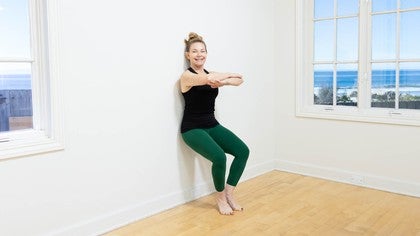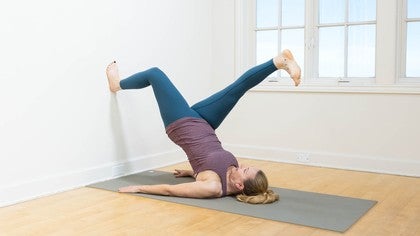Description
About This Video
Transcript
Read Full Transcript
Let's go ahead and get started. All we're going to need for class is a wall space. Not very much at all in fact, you're probably just gonna span your arm width, and maybe your arm height around you. All right, that's really it. So let's go ahead and get started at this wall here and think about the wall, what I want you to think about the wall is like a mat on the ground, really in a vertical orientation.
What's nice about doing mat work or mat exercises at the wall is it's direct feedback and it's a little different kind of feedback than you get on the ground. And I'll point out when I'm talking about that specifically, you'll feel it I think, we're in gravity up here. So not only do we have gravity, kind of the force of gravity pushing us and we're trying to manage ourself in gravity, we've got the solid wall to give us the feedback as well. And so let's talk about that real quick. I want you all to bend your knees a little bit, walk forward away from the wall.
We'll start in a parallel position with your legs here. And so with the shoulders, we want, ideally right across the line evenly, okay. And then feel the back of your shoulders evenly on the wall. So right away, if you feel one higher than the other one on that wall, we're looking to have it even, okay. Same with the pelvis, and we all know that, we talk about the pelvis all the time, you can kind of just landmark it by just bouncing your pelvis a little bit.
We don't want one hip in front of the other. And then we want shoulders over the hips. Okay, so that's kind of a basic square or basic rectangle of orientation there. Now let's feel into the back of the body. Sacrum, we just went there back of pelvis, your thoracic ribcage, think right opposite of the bottom of your sternum here against the wall, so we don't have the wall, or the ribs away.
Okay, and the back of your head, if you can, so move of your heads maybe out front. I don't want you to get your head on the wall by lifting your chin up. So if your head is not there right now, let's just be patient, let's focus mainly on this trunk part of you, okay. And then also real quick check in here. I want everyone to reach behind you with your hand and notice the lower back curve, your natural curvature here.
Please keep that at this point. I don't want you to smash it or press it yet, we will in a minute. All right. So this is our natural position I want you to feel. Arms just dangling loose.
Let's just take a few deep breaths and just use your exhale. Normal breath. So if we were on the map, this is how you'd want to feel in your natural spine, okay. Now let's do a little movement to feel the difference between your natural spine and pelvis, right. So you've got this hip, hip pubic bone in line with ribs versus a pressed lower back.
So if I use my abdominals, as you will too, pull 'em in, press 'em in and see if you can get the back of your waist closer to the wall. Some of you may get that quickly, some of you may need to practice this a little bit, so release it. And then again, as we activate the abdominals to press in against you to the lumbar vertebrae on the wall and release. A little hint, if this is already kind of like, wow, I can't get there. Walk a little further forward, couple inches, bend your knees a titch more.
That may help you. Okay, I'll stay there. So let's take a breath. And as we exhale, so we go from this natural to a pressed lower back, and I want us to hold this one, hold the feeling of it. So can you feel the activation of your abdominal muscles pressing in?
It's gonna be the front, it's also gonna be the sides right here kind of narrowing in at the base of your ribcage. Let's hold that for a little bit longer. Okay. Yeah, like you're kind of pulling yourself into a really tight seatbelt or tight pair of pants or a skirt or, you get the idea. Okay.
That's the way we can activate that deep internal part of yourself, now let's let it go. All right. Now let's do some movement there with that. So take your legs in a slightly different position. I want you to take the turnout.
So your legs are a little outwardly turned, your heels are together, toes are away. Let's start in this natural place. Arms just loose, breathe in through the nose. Now, as we roll off the wall, this is an articulated motion. So we move ahead and the neck and you'll notice you get to about your shoulder blades, and then I want everybody to lightly press their back into the wall, feel that tummy activation, and then start to roll off of the wall.
Keep your arms dangling loose. We don't have to go too far down. So everyone we're right now still with a little bit of bent knee position, take a breath there. As you start to roll up, it's the pelvis, the back of that pelvis I want you to get back on that wall. And then as you start going farther back, you're also going up the wall up and back, up and back, you feel that pelvis get placed.
Your spine is natural and you come right back up to standing. Okay. I'm gonna do it another time with my legs straight. You can try this with me, inhale, exhale, and then we roll head and shoulders and you're gonna feel your low back press into the wall. Coming from here, roll off the wall.
Arms are just loose, our knees are straight, but not locked and pushing backward. If it feels good to go all the way down and touch your toes, that's pretty nice to do, inhale there. Now we get to roll up. This is so wonderful. It's the back of your body going up that wall, your pelvis.
I actually kind of feel like I'm sliding my pelvis down the wall and now going back to it. And as I get my pelvis on the wall, I wanna think, I'm going back and up, back and up, back and up, back and up. Relax that lower back, so you're nice and natural. Okay, let's do it with legs parallel once. Bent knees again, nice normal position, natural position to start, take a breath.
So we're rounding the head, the back presses into the wall and you're gonna peel yourself down. Now I've showed the turned out leg position as well as this parallel position. Both offer very similar ideas, but slightly different sensation in your low back spine. The leg angle really can make a difference on how you clearly articulate and get that mobility through your lumbar spine. When you're coming up higher, where you get yourself back in that natural position.
Okay, natural, meaning you're not pressing your back. Wonderful. Okay, everybody just stand straight for a minute and just kind of wiggle your legs. Let's connect some more upper body with this. All right.
So you can stand in that little outward rotation. I like to offer this because it's pretty traditional on our mat work, press the heels together. You wanna feel like your whole inner seam of your legs are really pulled to the midline and you'll probably start to feel some work in your outer hips also coming in, such a great connection. Keep your back natural. Okay.
Take your arms straight, right alongside the frame of you. And just take a moment for a second here, feel your shoulders, are they forward? Remember at the warmup, we pressed them back. So I want you to feel the back of your back, the back of each shoulder, evenly into the wall. Take a moment to feel that.
Okay. So again, the wall is like vertical mat. When you're on the floor out of gravity, that might not be easy to feel. All right, so as you're pressing the wall, really press the wall with your arms, the back of your shoulders. Okay, feel what you feel, hopefully kind of some side back muscle and then release it, and then press again.
Let's hold it for three, two and one, release. Couple more. So we're working the back muscles along with the abdominal muscles, the back of shoulders, the spine. Okay. And then one more time.
Now feel the quality of contraction in your back and your shoulders and your abdominals. Can you feel that even when your arms are out here, away from the wall? It's interesting and that you can feel it, and then start this interesting little pumping motion of your arms. So it's as if I'm still pressing my arms all the way backward, but they're out here. Okay.
Now let's combine that with a little forward roll off the wall. So we'll start in our natural. Here we are, knees can be a little bit bent, it's fine, and I want everyone to let their head roll forward and let their shoulders roll forward. The right at the end of your sternum is pressed against the wall, and right now I want everyone to press their low back against the wall. So you've really got this nice center connection.
And then I want you to start this arm movement, and let's do a little, a rhythm of breathing, we'll do inhale for two, exhale for two. Concentrate on keeping your arms pressing back and your spine against the wall. Keep going, and. Now you have to keep going as I cue you, that part of your back that's on the wall, make it longer up the wall. Did you feel that?
And pull into the wall. The wall is like the floor and eight, seven, six, five, active legs also on that. You could keep going, but for right now, I want everyone to roll on up and just let their spine be their natural spine. Okay, so when we're on the floor, there's a pretty common exercise in the mat, we're called the 100. And of course there are 100 pumps.
You could practice it up here. Really nice way to build the strength. Here, your connection on the wall before you get out of gravity and have to hold your legs up in the air. A whole nother story. Okay, great, shake your legs out.
Now, let's get it into our legs, speaking of which, and I want you to stand still in that Pilates stance. Okay, heels together, toes are away, natural position, arms against the wall first. We are going to do something called footwork. Now, as you bend your knees, the tracking of the comes out over the second and third toes, your head, your sternum spine, the base of your sternum and your pelvis stay on the wall. You might wanna press your back in, that's okay.
But I just don't want you to tuck your hips here. Okay, you look at what that looks like, not a great alignment. Here's natural. Can you go down and up the wall? So we bend the knees and we straighten the knees.
You can press your back down, it feels pretty good. I like the lower my legs go, the more I can activate to press up my back. Okay. Keep going, arms are gonna be folded now. And we lower and we stand, and shoulders are back and we stand.
So all those landmarks we did at the beginning, still happening here, you're going straight down, straight up, lower your arms and pivot into a parallel line. Let's do it again, bend, straighten. Now, if this is bothering your knees, two or three workarounds, go smaller range, step a little further away from the wall. Those are my two offers, okay. Fold the arm, same thing, down.
Now here you wanna be evenly going, not crooked, not one hip in front of the other hip. Shoulders are back, mid back is there, pelvis is on the wall. And okay, it's gonna get more fun. Pull it down and hold. You get to choose how low you stand.
Arms back, we're going to lift our heels, lower the heels, lift the heels, lower the heels, lift the heels. Let's press the back into the wall because our stomach is getting more used to this, right, and fold and lower, up and down. Building some leg strength as well. Keep your shoulders back, now hold. One heel, one heel, one heel.
Good, so as you alternate the heels, keep your spine tall on the wall. Low back, pressing as much as it can. four, three, two, and one. I want you to lift both, lower both, lower your arms and just straighten, how'd that go? Good.
Getting the feeling of it, getting your body against the wall. Okay, step a couple more inches forward. Pelvic curl, so we're moving into spinal stuff here, okay. More articulation and mobility. So I have try to go pretty, you know, not too low.
You don't have to start at 90/90, hips a little bit above your heels is fine. Arms by your sides, take a breath. Let's start with the pelvis and really pull the pelvis back against the wall. Articulate, now I'm gonna stay looking straight ahead so that I can feel that each shoulder is back evenly. And as I peel off the wall, aiming the knees right out over those second toes.
I don't wanna push my ribs forward, I wanna elongate my spine out that direction, feel some work back here, breathe. Start to come back to the wall with your spine. How many a vertebra can you get on that wall? All the landmarks. Okay.
Yeah, get into your natural spinal position. Breathe in, let's do three more, exhale, roll. This usually takes place on the floor. It's pretty nice on the wall. Shoulders are back.
You use those shoulder extensors, keep 'em there. Knees out over toes, and roll. Okay. Two more times, inhale and roll. So this is another place pelvis could rotate.
Try not to let it, try not to let it, inhale and exhale. Your long in your spine, you're doing this really wonderful curling movements, inhale and exhale, coming back. And yes, your thighs are working, getting some stretch in your quadriceps they're important muscles everybody. Finish in a natural spine. Push yourself up.
Woo-hoo. Walk back, okay. Now, side standing. I want you to stand right next to the wall with your shoulder against the wall, body relatively lined up, shoulder over shoulder and hip over hip. And then what we're doing is pulling this arm in and pushing against the wall and just unweighting the inside foot a skosh.
It's really about this hip pressing this way. Okay. We're focusing on the stability and strength of the hip, which really plays a part in the wall. Standing facing work in a minute, press and hold. Now I am pressing the wall here.
I'm pressing toward the wall, with this hip and then stand nice and tall. So we don't really have the same feedback against our back like we did before, but feel as if it's there. Okay. And notice what you feel in your hip. All right, go ahead and step the foot down.
You could hold that for longer. And I wanna get going into the upper body work. So we'll just turn around real quick and then start in the second side. So arm is bent. You're at a natural stance, inside foot, you really just unweight it, you don't really have to lift it here.
You're knowing where you are over your standing leg. Activate the side of the hip as if you're pressing into the wall, but you're not really gonna do that. Right. This is preparing us for quality single leg standing everybody. Okay.
And how you stay aligned with your shoulders above your pelvis. All right, let's go ahead and put that foot down because we've got a lot to do for the upper body. So here we go. Everybody turn to face your wall. And I want you to start with your elbows bent, right angle here.
And if you can gauge it where your upper arm is straight in front of your shoulder, that's my ideal place. If you need to have your arms a little more open, please take that. You'll know in a minute if it feels a little uncomfortable and if so, you can just move your arm out. But generally what we wanna start with here is this, and I do want you to have your hands palms face down. Okay.
So your upper arm is in an outward rotation position on each side, but from your forearm and hand, you're face down, and take a moment to press all five fingers and pads into the wall. Okay. Now, here we are, feet are apart. You have no feedback behind you, but now the feedback's in front of you. So I want you to press the wall and notice how I'm spreading my shoulder blades wide.
Please try to do that. Okay, it's not a push of the rib cage, that's a different thing, this is the ribs are natural, your spine is natural and your shoulder blades move. This is pretty tricky stuff, but it's important. Now shoulder blades are gonna do the opposite. They're coming together and somewhat down your back.
That's called the retraction. Feel all the muscles really working to get the scapula closer and down the spine. The opposite is the protraction. Scapula is widen, retraction, scapula come back and down. Okay, let's do that a few more times.
With bent elbows, this is a really specific shoulder girdle, shoulder strengthening exercise. When you do pushups, which we're about to do on the wall here, we need this phase, we need both phases of going, shoulder blades go back, shoulder blades go wide. Keep your body in one long line. Okay. Yeah.
All right, we're gonna walk away from the wall now until the arms are straight, lower your hands just a little bit. Ideally, we're looking for the base of the wrist to be right in line with the base of the under arm here, this straight line. Again, do your best to keep your hands narrow. And let's start again everybody with a little bit of space between the legs, active muscles in the trunk to hold your body line. Okay.
Now, same idea, let's protract the scapula, push the wall away. We wanna spread the shoulder blades apart without pushing the ribs back, right, it's not a rib push, it's a shoulder blade movement. The opposite is true, the shoulder blades go back and down, that's that retraction and do back and forth. So we do this scapular retraction protraction a lot in Pilates to mobilize the blades, the shoulder blades around the ribs. There's a really great group of muscles working here that not only help the mobility aspect, but they play a huge role in stability.
Right now, they're doing the right thing in helping to mobilize. Okay. Couple more times. So scapula back, scapula forward and wide, one more, really trying to push the wall away, push the wall away. All right, now find a neutral, natural position of the scapula.
Take a breath. We're gonna bend the elbows and we're bending the elbows, I'd love for you to get your forearms all the way on the wall. Pause here. No rib cages should be moving when you push away from the wall, let's push, you're gonna feel the back of your upper arms. Now, what are the shoulder blades doing in this push up?
They do get to move everybody. They get move a little bit. So I'm widening 'em a little bit, retracting a little bit. And notice I cued the word little. It's not a huge movement, we don't wanna slide 'em all over the place, but you don't wanna fuse them into a locked position.
The scapula need to be able to move around the ribs naturally. It should be making your push up a little bit easier. Now, for those of us who like to do pushups on the floor, this also should be occurring. But if you don't like to do pushups on the floor, this is where you get to do pushups, is on the wall. Pretty nice.
The feedback is amazing for all of this here on back of the arm. Okay. Now keep on going, let's bring that single leg into this exercise again. That's where that single leg is gonna come in. Okay, you're balancing.
Now you've taken one base of support away, you don't wanna lose your balance or lose your spinal position or your older mechanics. One more with this foot up. Yep, a lot of pushups happening here, step down, right away pick up the other foot. And we do, let's do four. Now if you notice yourself wiggling or losing a little stability, that is a good thing.
The wall is teaching you, the gravity is being up and he is teaching you. We're trying to be as stable as possible and aligned as possible. Okay. Now bending again. We're gonna use the wall and jump away from it.
You may need to step back a little bit, yeah. And then elbows here, let's push, land with a little retraction in your scapula and a little protraction when you leave the wall, little retraction, little protraction. Now as you're doing this bigger movement, we want those abdominals in to support the spine, I'll show you one wrong way, I don't wanna do too many. We don't wanna have that whole line get broken. Right, so you're basically like a plank line.
Whew. We can go a little faster for eight, and seven. Whoo, six, how about one leg? Five and four and three, whoo, two. And exactly.
I'm glad I chose that, that's what I thought was what this is gonna teach me. So I might need to approach a little more stability work on that side. Okay, great. Stand facing the wall again to this side. Back where we were a moment ago and have your shoulder right against the wall.
This is now some ribcage and spinal mobility with more shoulder mobility. Okay. Have your hand here, slowly start to raise the arm. If you've experienced any shoulder discomfort in this series, just stop. If you have a rotator cuff injury or thing, maybe don't do this one right now, okay.
Now I'm just gonna tell you, if you feel like you can't circle your arm behind you, 'cause that's what we're gonna do, you may need to step your feet away from the wall a little bit, I'll show that. From here, start to move your arm behind you, you can turn your ribcage toward the wall, but try to have this pelvis staying facing front. So I wanna lift my spine up, turn my ribs toward the wall and watch that hand go back. Let's return ribcage. Still facing the wall, you can look at that hand, as you're coming up and as the arm comes more forward, the body faces your front. Does that make sense?
Now, if you feel like you have a lot of range here, go all the way in. I'm gonna stay out here. Palm facing the wall, belly button faces front, hip stay front. We're gonna work on the mobility of the thoracic spine where your ribs are and your shoulder blade. So your back muscle is really engaged here on the side of this body, your latissimus muscle.
Stand tall, you'll have more room for that arm circle. Let's go one more time. And sweep, use that wall. It's there for your feedback, rotate your chest toward it, but try not your pelvis. Oh, that's such good feedback.
Right. And then return, stand all, you'll have more room other side. Interesting, right? When we're down on the floor doing more rotational work, it's really nice to understand what your rib cage can do and how it might need to learn how to get more freedom. This is a great way to get that.
Okay, so here we go. I know my own shoulder on this side, I know I need to start a little farther away from the wall, but if you feel good, you can stand close. Here we go. Arm moves forward. So once it gets shoulder height, I'm gonna put my hand on my pelvis so that I keep my pelvis facing this way and allow my chest to start to turn toward the wall.
I've gotta use my back muscles on this side to help move the ribs, that direction and the arm and we return, stand tall, you'll have more room. We did three, here we go. Breathing in. How about an exhale, turn and arm comes down. Return.
I'd really love for your body to stay in a nice vertical orientation, your balance to be even on your feet. Lift that rib cage and try to turn it toward the wall. Keep your pelvis facing front. Ugh, so good, last time, and in, okay. Pretty powerful exercise for the muscles right here in your back, I hope you all can feel that.
Now face your wall again. Let's do a couple more facing and this is swan. Okay, so swan can be legs apart. Let's bring the hands about shoulder level, elbows on the wall. Get your face quite close to your wall everybody, in fact, if you wanted to put your forehead there, you could.
I'm just gonna keep my face hovered away. Now what I want you to do here, lightly drag your hands down the wall energetically and retract your scapula. Okay. Now again, it's not a push of the ribs. It's scapula.
Now we're going to work on spinal extension and a little upper back bend. So I want you to look up the wall with your eyes, your nose, chin, and your chest. Okay. Now you can have your chest stay on the wall, that's fine, retract more in your scapula, but what if you decided to come away from the wall, keep pressing your hips toward it, hips toward it, but your upper back away. All right.
And return to facing front. Couple more, so scapular retract, eyes, nose, chin, chest. So I'm extending the length up and trying to extend the length up and now back, retract your scapula, feel how the muscles of your back support you as you pick up your upper back spine and bend it backward. Right. And down once more, let's take your breath.
Retract, up we go. So you will feel your low back, but retract your scapula and you'll hopefully feel more of your upper back, right. You could even release your arms and just reach your arms up, up and up. Okay. Double leg kick or single leg kick.
Excuse me, single leg kick. Let's go back to where we were when we did that very first scapular retraction here. I want you to do this one, everybody with legs close together. Okay. Little bit of scapular retraction.
Pick up one leg, pull your heel toward your back hip and do a little double kick. We go boom, kick and down. Other side, and a kick, kick and down. So let's work the retraction, tummy in and a kick, kick. Keep pressing the wall.
Remember this is your mat on the floor, kick, kick. And as you change, get balance in your pelvis. Try to pick up your spine a little bit. Pick up your chest spine, retract your scapula. Press, be even once more each leg, kick, kick and kick, kick.
Yep, and no one had wiggly hips probably, right? Good. Okay. Let's do one final spinal articulation. I'm going to how we started class.
Landmarks of your back on the wall, just check in and see how you feel. I'm gonna ask you to stay with your legs straight. Does it feel easier to be here with your head, your shoulders, your thoracic spine and the back of your hips? Notice you may actually feel closer to the wall already or now after all of that work. So let's take a nice deep breath.
We'll do two roll downs everybody. Let that head come off the wall, let your shoulders come off, feel your low back meet the wall. And you'll just continue to peel. I want you to take your hands to your toes, inhale back and enjoy that roll up to standing so you slide that pelvis down. You feel how evenly you make them all on the wall, roll all the way up, we have one more opportunity.
Breathing in, be the tallest spine you've got. Take that nice tall spine, bend it forward, arms are loose, low back presses the wall, one last time today. Rounding yourself down. Beautiful movement, inhale and slide all the way down. There's your back against the wall, you're even, and bring yourself all the way up.
And as we finish, we're just going to step right up to a final stand. And thank you so much for joining me today.
Empowered Aging: Active Aging with Amy Havens
Comments
You need to be a subscriber to post a comment.
Please Log In or Create an Account to start your free trial.
















